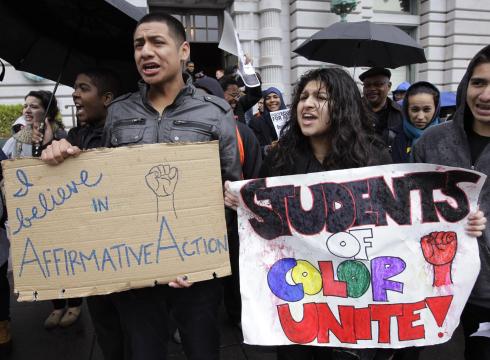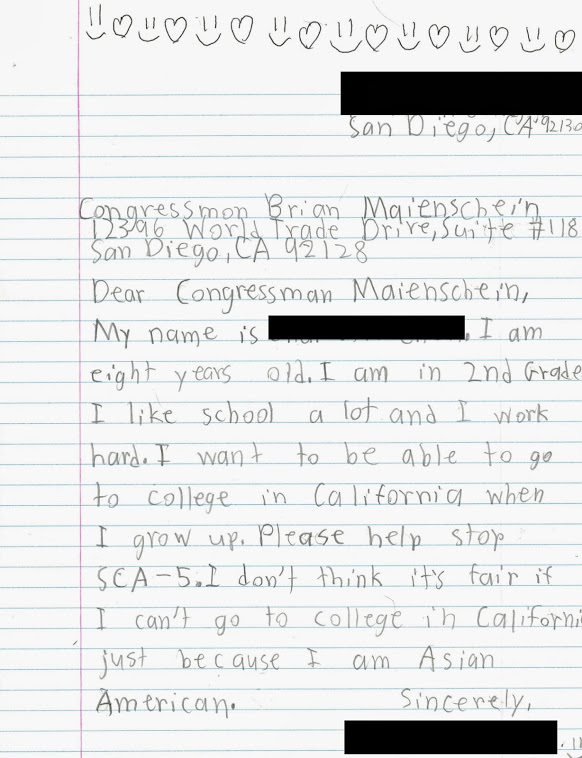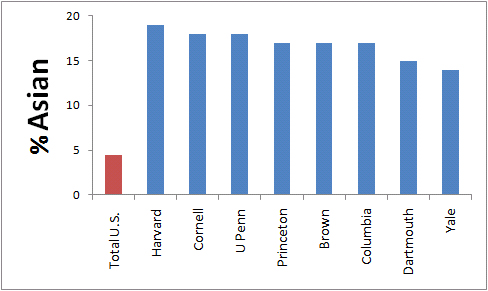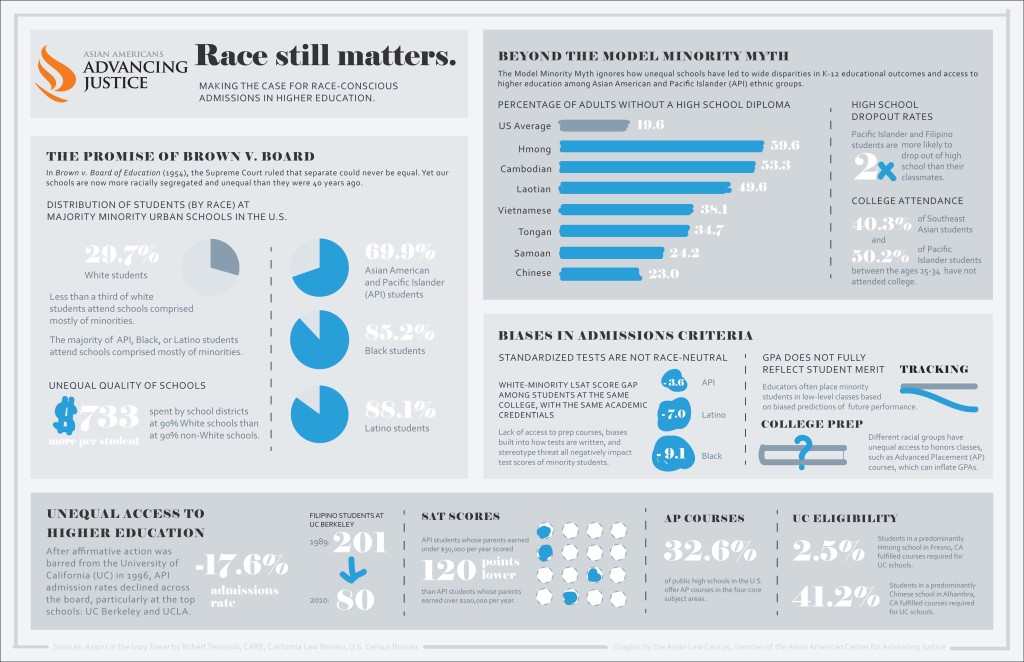
Nearly twenty years ago, California voters passed Proposition 209, a ballot measure that effectively outlawed affirmative action in state-run institutions. Among other effects of Prop 209 was the loss of affirmative action policies — the ability for college admissions officers from being able to consider race among other application criteria — in the state-wide UC college system.
Prop 209 has had a devastating effect on UC schools: Black, Latino, Native American, Southeast Asian American and Pacific Islander admission rates have dropped precipitously relative to the pace of their population growth over the last twenty years, resulting in a public, taxpayer-funded university system that has effectively excluded many of the state’s underrepresented minority community — roughly 45% of the state’s total population — from access to quality secondary education.
Currently, the California House and Senate are considering Senate Constitutional Amendment 5 (SCA5), a bill that would create an exemption for public education from Prop 209, re-empowering the UC system to once again employ reasonable affirmative action policies in their admissions process. Should SCA5 pass the California Senate later this year, it will be put on the November ballot for public consideration. Passage of SCA5 is a necessary first step to restore access and equality for California’s underrepresented minorities to a college education.
Unfortunately, although 61% of Asian American voters in California voted against Proposition 209 in 1996 to protect affirmative action, recent efforts by conservative Asian Americans — predominantly Chinese American non-profits and news outlets — have resulted in a widespread campaign of misinformation and outright fear over SCA5 in many Asian American voters.
To set the record straight, here are the top 5 myths — and facts — about SCA5, and why you should support it.
Myth #1: SCA5 violates the Equal Protection Clause and is unconstitutional (from SiliconIndia).
Fact: SCA5 will not empower UC colleges to legally violate the Equal Protection Clause of the U.S. Constitution for a few reasons: 1) state law does not supercede federal law or the U.S. Constitution, and 2) affirmative action programs are currently practiced in many public universities throughout the country without violation of the Equal Protection Clause. Specifically, in the landmark Grutter v. Bollinger U.S. Supreme Court case of 2003, use of racial information as one of many criteria considered in college admissions was found to not violate the Equal Protection Clause.
Wrote Supereme Court Justice Sandra Day O’Connor in the majority decision:
[The U.S. Constitution] does not prohibit the law school’s narrowly tailored use of race in admissions decisions to further a compelling interest in obtaining the educational benefits that flow from a diverse student body.
Myth #2: SCA5 will prevent an Asian American applicant from college admission “because they are Asian” (letter imaged below).

Fact: There is zero evidence that any college admission officer has ever rejected an applicant just because they are Asian. Zero.
Many anti-affirmative action Asian Americans cite a decade old study by Thomas Espenshade that purportedly presents evidence of an anti-Asian bias in college admissions. However, there are several flaws with this study: first, Espenshade generalizes findings from seven private Ivy League elite institutions to all colleges, including public and state universities that have broader and more inclusive admissions criteria. In addition, supporters of Espenshade’s data have failed to consider the impact of the far larger number of Asian American college applicant pool on the calculation of Asian American admission rates. Finally, Espenshade failed to consider the state of origin of Asian American applicants studied; international students often have, by virtue of their nationality, separate challenges to college admission in the United States. I have written a two-part post documenting the problems with using the Espenshade study as evidence of widespread anti-Asian bias that I strongly encourage you to read.
Either way, even if you believe Espenshade’s data, they do not point to any explicit or implicit college admissions process wherein an Asian American applicant is ever rejected based solely on his or her race.
Myth #3: SCA5 will legalize racial quotas that will cap Asian American admissions to the UC system to the size of their state-wide population (email reproduced at 8Asians).
Fact: This form of affirmative action, which sets an a priori cap on accepted students of a certain race, is called a racial quota system, and it has been ruled unconstitutional by the U.S. Supreme Court. This form of affirmative action was not practiced in the UC school system prior to Prop 209, and is not practiced in any non-California college that currently employs affirmative action in their admissions.
Prior to the passage of Proposition 209, the size of the Asian American population on UC campuses was roughly 20%, roughly double the size of the state’s overall Asian American population — 9% of the state’s total population — at the time. Currently, most schools also have a similarly large Asian American population relative to our population size, strongly arguing against any school’s use of a supposed “racial quota” system relative to national or state-wide demographics.

In short, there is no reason to think that a racial quota will be implemented in California UC schools following passage of SCA5.
Myth #4: Affirmative action lets in “unqualified” or “less qualified” Black and Latino students over more qualified Asian Americans, and a college admissions system that only considers grades and SATs is more fair and objective (from 80-20).
Fact: Again, because racial quotas are unconstitutional, there is no evidence of Black and Latino students being admitted to college based solely on their race. Instead, most colleges use race as only one of several factors they consider in making admission decisions. Further, the assumption that Black and Latino students who are admitted in part as beneficiaries of affirmative action assumes — in a highly racist manner — that these students are, by default, not intelligent enough or prepared enough for college, a racial stereotype that no one should engage in. Yet, many make the assumption that underrepresented minorities who benefit from affirmative action are less qualified, and they base those assumptions on SAT test scores.
The SATs has its origins as an Army-implemented IQ test, and was adapted to widespread use under the assumption that it was a fair aptitude test that objectively measured intelligence. However, numerous groups including parents, students, teachers, and colleges have pointed out the glaring problems in the SATs, and the myth of its objectivity.
First of all, the SATs are easily “hacked” by students who pay thousands of dollars to SAT prep courses to improve their scores. This New York Times article reveals how students are taught exam prep tricks — not knowledge — to improve their score, and how certain aspects of the SATs can even reward you for wrong information, particularly in the exam’s essay section that were specifically introduced to improve the SATs’ ability to measure a student’s aptitude (emphasis mine).
[Les] Perelman had been conducting research that highlighted what he believed were the inherent absurdities in how the [SAT] essay questions were formulated and scored. His earliest findings showed that length, more than any other factor, correlated with a high score on the essay. More recently, Perelman coached 16 students who were retaking the test after having received mediocre scores on the essay section. He told them that details mattered but factual accuracy didn’t. “You can tell them the War of 1812 began in 1945,” he said. He encouraged them to sprinkle in little-used but fancy words like “plethora” or “myriad” and to use two or three preselected quotes from prominent figures like Franklin Delano Roosevelt, regardless of whether they were relevant to the question asked. Fifteen of his pupils scored higher than the 90th percentile on the essay when they retook the exam, he said.
With the Kaplan prep course producing significant improvement in student scores in a billion dollar industry, the SATs are no longer an objective measure of student aptitude (if indeed they ever were). Instead, the SATs most closely predict the economic privilege of the student taking the test; those who can afford exam prep courses do better. In addition, the SATs have been widely criticized for the cultural and racial bias in their questions, and it goes without saying that the SATs, being available only in English, puts ESL students — many of whom are AAPI — at a serious disadvantage. Furthermore, the SATs and high school grades have been found to be an extremely poor predictor of college success: a recent study shows that colleges that have chosen not to consider SAT scores have “virtually no difference” in college dropout rates as those that do.
Thus, using grades and SAT test scores as the sole basis for college admissions isn’t more objective. Instead, it limits admissions officers to subjective and unfair criteria that disproportionately advantages wealthy applicants, and that studies have shown fail to produce meaningful predictions of aptitude.
Myth #5: Affirmative action only helps Blacks and Latinos, and hurts all Asian American/Pacific Islanders.
Fact: Despite the race-baiting of groups like 80-20, which took great pains to point out that SCA5’s sponsor is Hispanic, affirmative action is not a policy that only helps Black and Latino students. Affirmative action policies help all underrepresented identities from a diversity of backgrounds, and (under Title IX) has most notably helped achieve admissions parity for female students in higher education. Currently, students of many racial identities are underrepresented in UC colleges, including many ethnicities that identify with the larger Asian American and Pacific Islander racial identities, and restoring affirmative action to the UC college system will help many of these AAPI students.
More importantly, homogeneous student bodies breed homogeneity in thought. Encouraging diversity in the UC student body will foster a broader representation of divergent viewpoints in UC classrooms, critical for high-quality education. A college education is not just about earning grades and degrees: it is about expanding a student’s horizons through academic debate and dialogue. Asian American students, even East Asians who are not beneficiaries of conventional affirmative action programs, will have access to a far improved college education when campus diversity is improved. Writes the National Commission on Asian American Pacific Islander Research in Education:
[R]esearchers found that informal interactional diversity – attending a cultural awareness workshop, discussing issues related to race, and socializing with people of different races – was a positive predictor of higher levels of intellectual engagement, academic skills, civic engagement, and racial/cultural engagement for Asian American college students.
Despite the fear-mongering of extremist anti-affirmative action Asian American groups in recent weeks, I am optimistic that most of California’s AAPI voters will see through the hate and vote to restore affirmative action to the UC. Indeed, in a recent comprehensive study of Asian Americans, the National Asian American Survey found that roughly 70% of Asian Americans support affirmative action programs.
Please don’t let the lies and misinformation surrounding SCA5 continue to position Asian Americans against other minority communities. Even if you’re not a California voter, Asian Americans need to stand in support of affirmative action, and against hateful and misinformed race-baiting rhetoric. Spread this post widely and tweet your own support of SCA5 to #NoLiesNoHate and #StandWithSCA5.
More Links:
- AAAJ release on SCA5 and affirmative action
- AAAJ factsheet on affirmative action (.pdf)
- LA Times: Affirmative action at California colleges: A debate based on fear (Op-Ed by Karthick Ramakrishnan (@karthickr))
- Primer on affirmative action by Oiyan Poon (@spamfriedrice)
- CARE report on how AAPI students benefit from campus diversity
And from AAAJ:

